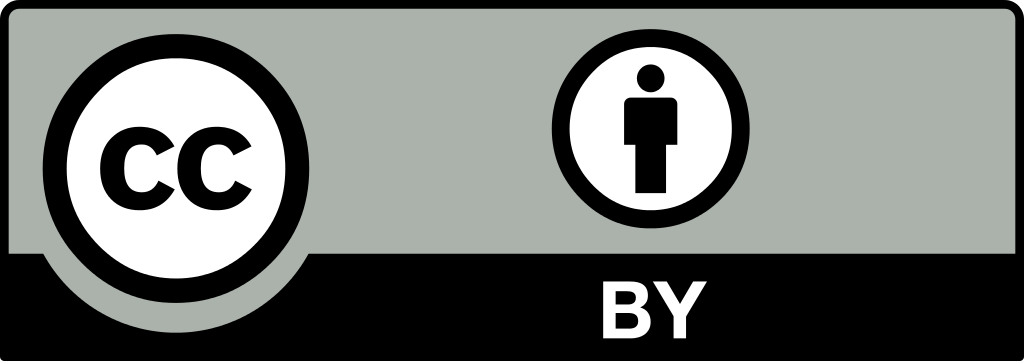Visualizing Law’s Pluralities
Artistic Practice and Legal Culture
The interrogation of the cultural construction and negotiation of legal practices in the conference Law’s Pluralities: Cultures/Narratives/Images/Genders (Giessen, Germany, 2015) offered a stimulating occasion for the presentation of pertinent artistic works. The international artistic positions by Il-Jin Choi, Raul Gschrey, Mi You, and Manu Luksch reflect upon social and legal frameworks, and demonstrate means to visualize phenomena that often remain abstract. The artistic interventions themselves are also productive: through their explorations, contestations, and subversions, they participate in an alternative production of knowledge; they mediate and shape legal practices. As Greta Olson, one of the organizers of the conference, argues: “legal phenomena need to be understood as cultural-political processes that are made sense of, and disseminated through, culturally specific performances, narratives, topoi, and images.” [1] In this respect, the artistic positions constitute viable, alternative means in making sense of the pluralities of laws. Their contextualization and interpretation, as part of an academic conference and in this article, follow calls for an expansion of trans-disciplinary and culturally oriented research on law and legal cultures. [2]
In the somewhat divided role of artist, academic, and curator of the exhibition, I present what are necessarily personal perspectives on individual artworks in relation to the topic of the conference. While some works cluster around issues of surveillance, security and privacy, others propose more symbolic readings of the plurality of law, deal with translations of legal texts and contexts, and struggle to create alternative visualizations. I begin with a few words on the curatorial concept behind the exhibition as part of the conference Law’s Pluralities. I then explore individual artistic positions and their connections to legal writing and practice in overregulated urban spaces. I conclude with some thoughts on the potential of artistic approaches in visualizing, subverting, and critically contextualizing the pluralities of laws and legal practice.
1_Curating Law’s Pluralities
The exhibition Law’s Pluralities was part of the international interdisciplinary conference on the cultural foundation and negotiation of legal practices. The exhibition was mounted in two venues in Giessen, Germany: artworks were presented in the main university building of Justus Liebig University, where the conference took place, as well as at the Neuer Kunstverein Gießen, a local art association located in a former kiosk on a busy street within walking distance of the campus.

Integrating the artistic program into the conference was a deliberate curatorial decision, an effort to thereby to expose the guests — practitioners and theorists from different academic fields such as literary studies, cultural studies, visual arts, and law — to the artworks throughout the event. During the conference, the exhibition venue in the university doubled as conference office and central meeting place. The academic event was not intended to remain a closed sphere. This was the motivation to show artworks in the Kunstverein: to address a wider local public and to introduce international academics to Giessen’s local art scene. The Kunstverein exhibition extended not only the spatial, but also the temporal effect of the academic event. This exhibition remained open for weeks following the conference, and was frequented by an academic and non-academic audience.
The small space of the former kiosk and its glass front allowed for interesting perspectives on the individual artworks, and created a site for productive dialogues in both form and content among the artistic positions. The perspective from the outside — looking, from the public space, through the windows onto the artworks and the visitors — created a special atmosphere of seeing and being seen. This perfectly matched the topic of the exhibition, shaping both the curatorial concept and the presentation of the artworks. As artist and curator alike, I am convinced that it is essential to offer vantage points for reading and interpreting the videos, photos, installations, drawings, sculptures, and texts. Exhibitions — in the joint presentation and contextualization of artworks and their relationships to each other — become powerful ways of telling stories: stories that necessarily remain fragmented and open to individual experience. Here, however, I will propose certain storylines and readings of the exhibition in the context of the conference Law’s Pluralities.
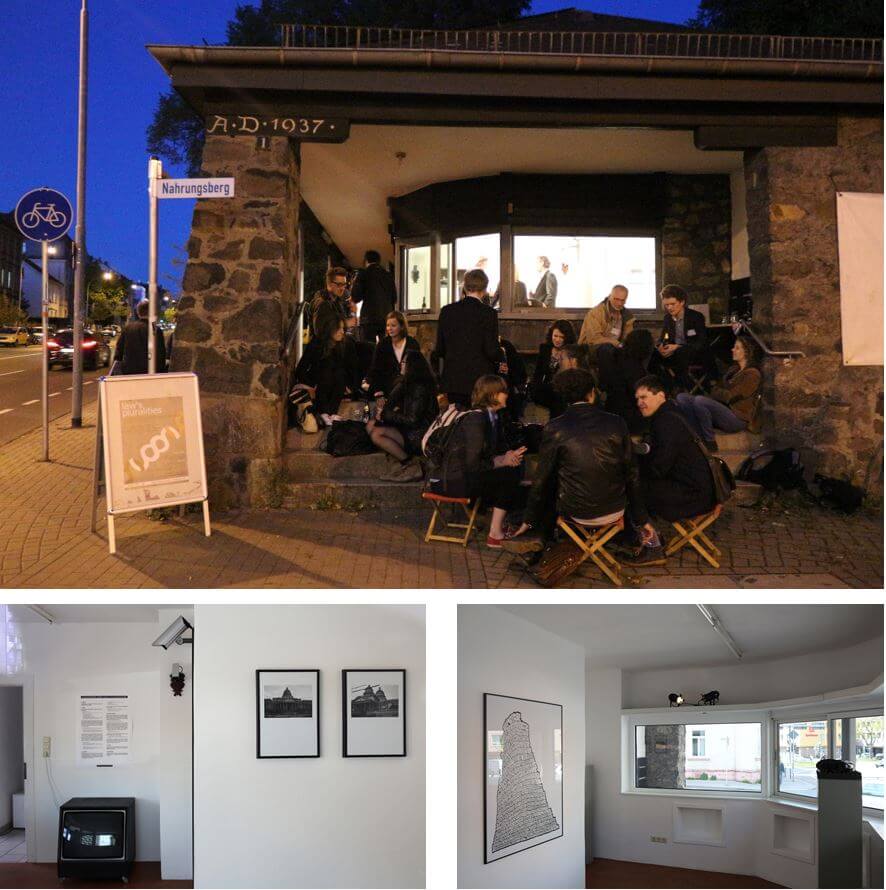
2_Contesting Surveillance: Mappings and Legal Readymades
Surveillance in public space is a central focal point of a number of the exhibited works. The phenomenon of visual surveillance, often referred to as CCTV (closed circuit television), has become omnipresent in our cities, and it represents a controversial political and legal issue. The demand for increasing video surveillance seems to be an almost automatic reaction in current European security debates concerning the rising fear of terrorist threats. But the installation of CCTV also affects issues of privacy, personal rights, and legal evidence. In contemporary arts, these surveillance practices and their legal backgrounds remain contested. London-based artist and filmmaker Manu Luksch is a prominent artistic voice in this controversy.
The video Mapping CCTV around Whitehall, documents an intervention by Manu Luksch in the government district of London, and the legal discussions into which the artist was drawn by policemen. In the video, Luksch is asked by these authorities to show her passport, the carrying of which is not a legal requirement in Britain; her bag is searched; and the Prevention of Terrorism Act of 2005 is cited. The act remained a highly contested legal issue in the years to come and was updated by the Terrorism Prevention and Investigation Measures Act of 2011 and the Counter-Terrorism and Security Act of 2015. In a striking scene from the video, one of the officers does not get the name of the outrageous anti-terror legislation quite right. The following discussion reveals an encounter between a well-informed artist acting in public space and the representatives of a security force that seem to be uncertain about the legal basis of their actions while struggling to maintain their authority.

For her project, Luksch documented the existing cameras in this public space, and produced a map of the district. This was followed by a series of performative interventions in which she used a mobile receiver to catch wirelessly transmitted video signals and then marked the visual range of these cameras with adhesive tape. Luksch then distributed leaflets and maps of the area to the passers-by. In these acts, the artist links the tactics of mapping and raising awareness with performative interventions. As I have argued elsewhere, [3] Luksch’s intervention can be read in terms of activist artistic practice and guerrilla theatre, using public spaces and streets as stages for an alternative way of protest. Anti-surveillance performances take place in increasingly contested spaces, and position themselves against forms of visual surveillance that are primarily aimed at maintaining public order and pose a threat to privacy, while proclaiming to be effective means against terrorist threats. Luksch’s video presents the artistic subversion as a playful intervention, making fun of the shortcomings of video surveillance systems. The artist diverts video signals and takes snapshots of CCTV cameras; kids play with the markings on the streets; and a lively soundtrack emphasizes the rapid cuts. But the lightness of the video is countered by its intense content. The video succeeds in conveying its political relevance and subversive potential, in particular in the scene when police officers try to put an end to the action. Luksch manages to unmask the omnipresence of surveillance architecture, our carefree behavior in spaces under surveillance, and the far-reaching legal potential of state power to intervene in a tightly regulated and monitored public space.
In her Manifesto for CCTV Filmmakers, exhibited here as a poster, Manu Luksch takes her subversive approach a step further. She invites both the public and, in particular, fellow artists to become active, to stand up for their rights and to challenge the visual power apparatus with the help of privacy law. The UK’s Data Protection Act grants individuals who have been filmed by a surveillance camera access to the recordings of their images. In her manifesto, Luksch reveals possibilities of working with CCTV material that is produced by private and state institutions, offers legal and technical advice, and sketches out the steps necessary to gain access to the source material that can be used as footage for ‘CCTV filmmakers.’ The artist adopts legal language in her manifesto; its critical potential evolves from Luksch’s sober, sans-serif, black-on-white layout of excerpts from a legal text. But behind the impassive tone of the guideline lies a specific situation: the display of vulnerability in front of the cold eyes of a CCTV camera; the display of emotional distress being a legal prerequisite for gaining access to the material. Luksch’s work raises an important question here: in the case of a legal dispute, how might institutions or courts be able to determine personal vulnerability and distress?
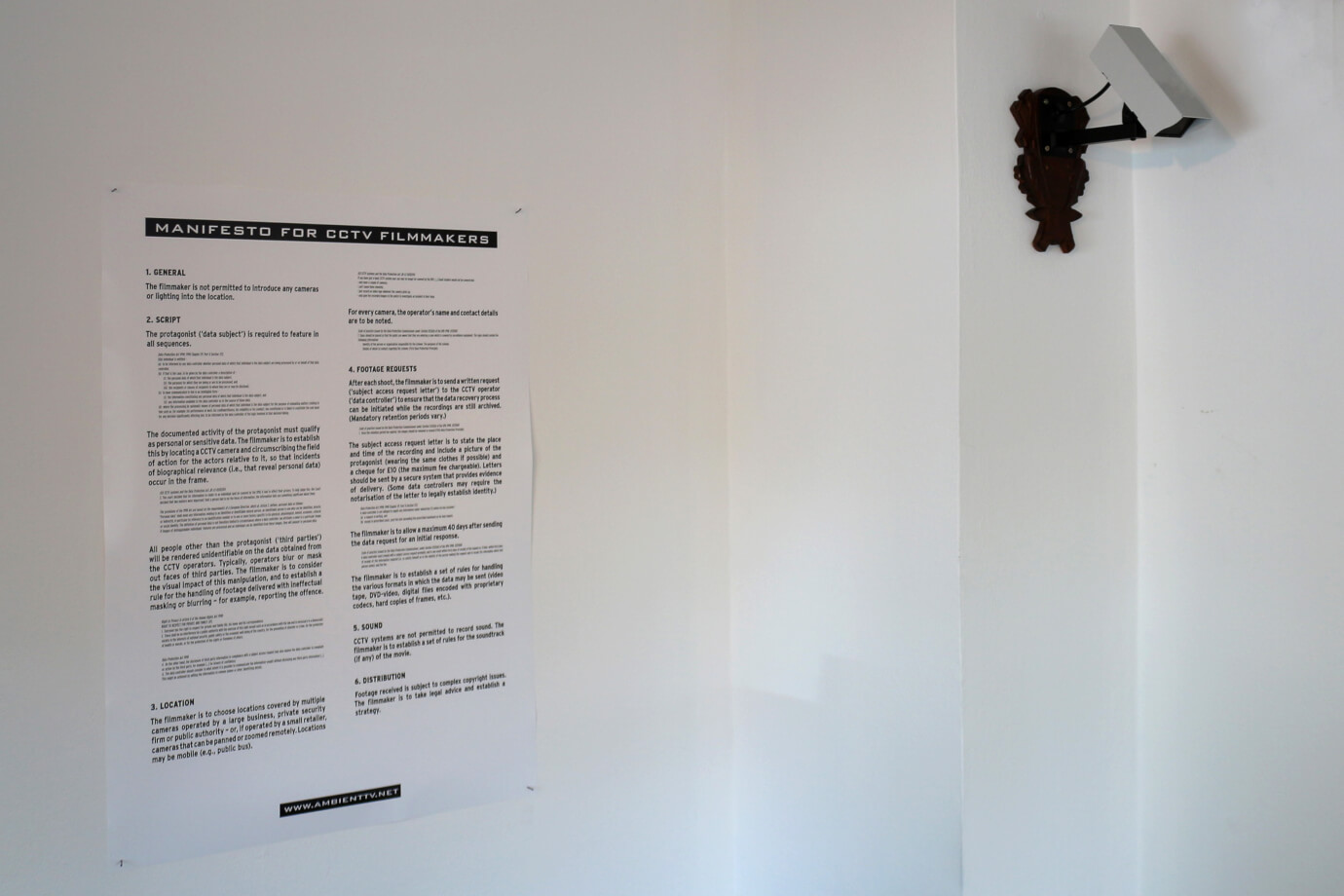
Read Manu Luksch’s Manifesto for CCTV Filmmakers.
Following her manifesto, Manu Luksch puts her idea of a CCTV film into practice. In the work Faceless, which was well received in arts and academia, Luksch constructs a fictional narrative on the basis of her “legal ready-mades.” [4] In this feature-length film, the main character tries to re-establish power over images of herself. In an effort to assert her individual identity, she embarks on a veritable struggle to regain her face in a crowd of anonymized “data bodies” in an urban landscape that remains opaque in the particularly framed, often-blurred black-and-white representations of a city. In the past decades, other films were produced that were composed entirely from surveillance material, [5] but in contrast to them, Faceless was created without the consent of the “surveillers.” Luksch does not cooperate with the institutions, but employs a trying legal strategy to gain access to the material. In a David-versus-Goliath manner, she uses her own body to open the closed circuits of the CCTV systems and their temporal and automated modes of recording to the public.
Watch an excerpt from Faceless.
Luksch’s Manifesto for CCTV Filmmakers and her film Faceless constitute subversions of the practices of visual surveillance and negotiations of its legal framework. The objects of observation become the protagonists in an uneven struggle for the right to privacy. Their bodies and behaviors provide keys to gaining access to their images. Luksch’s characterization of the protagonist as a ‘data body’ hints at implications that go beyond the visual realm:
Physical bodies leave data traces: shadows of presence, conversation, movement. Networked databases incorporate these traces into data bodies, whose behaviour and risk are priorities for analysis (by business, government). The securing of a data body is supposedly necessary to secure the human body (either preventively or as a forensic tool). But if the former cannot be assured, what grounds are there for the trust in the latter? [6]
The connection between the human body and its virtual counterpart in databases reveals concerns about the integrity of the subject that tie in with theories of leading Surveillance Studies scholars who speak about “data image” [7] or “data double.” [8] The concepts are used to describe the invisible yet influential network of data that in virtual space accumulates around individual persons through private, commercial, or administrative actions. This extends the reception of the artwork beyond a critique of visual surveillance practices, and expands the perspective towards non-visual collections of data and our role as subjects in digital environments. [9]
3_Contesting Surveillance: Performing in Surveilled Space
In a number of performances and interventions, I have examined visual surveillance in Germany, primarily in Frankfurt and the Rhein-Main area. [10] My approach defines streets and squares as performative spaces. The areas that are covered by CCTV are framed as potential stages. The works call on the public to leave their passive role and become active participants in this special form of interaction between observer and observed. Furthermore, the interventions examine rules and regulations for the behavior in public space. How far can individuals and groups go? When are their actions stopped, when are they prosecuted? How can public space be used playfully under the electronic eye of the surveillance camera? My strategy constitutes a way of exploring current conditions and social phenomena, such as the actual application and implementation of laws and regulations in public space. Furthermore, this playful approach offers interesting ways of addressing and involving the public and can evolve into a strategic form of protest.
In my performative intervention, the camera rarely shows the horizon, words and sentences written on transparent foils are fixed in front of CCTV cameras. The signs address the operators of the cameras, and comment on their situation as observers. The signs do not attack these potential viewers, but try to engage in a lighthearted dialogue, or try to make the viewers think twice about their role as voyeurs.
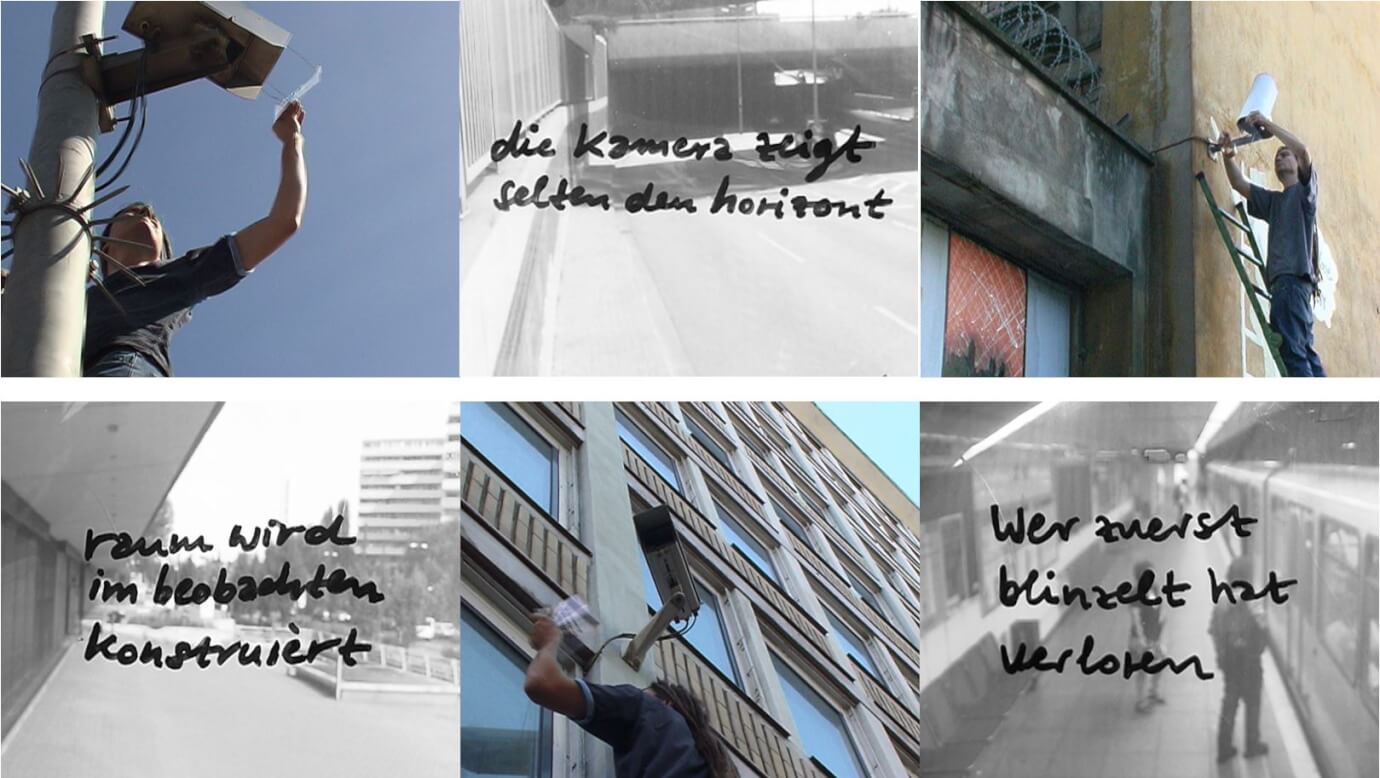
Interestingly, while working on the piece, I was not once confronted by authorities. In fact, there has usually been no reaction to these or other performative interventions I have staged in front of surveillance cameras. Here it becomes apparent that CCTV does not work, at least not in the sense that is generally expected. CCTV’s preventive capacities are low, and there are few possibilities for surveillers to react or intervene in events as they are unfolding, but it can be used as a forensic tool and as evidence in legal trials. Studies show that CCTV is not an effective instrument for the prevention of criminality. Unplanned, emotional acts are not affected by the presence of surveillance cameras, and premeditated criminal actions are transferred to spaces not under surveillance. Unsurveilled spaces therefore become potentially dangerous, often leading to a further extension of the surveillance regime. [11]
But shall we as artists now pack our things and head back to our personal ivory tower, the studio or white cube? My answer is: No! Because CCTV does work, albeit in different ways than may be expected. For one, CCTV is costly and self-perpetuating, and it changes our cities, their architecture, and the perception of and behavior in public spaces. Furthermore, newer generations of cameras and surveillance systems are becoming increasingly automatized and ‘intelligent,’ through techniques of facial recognition and behavioral pattern recognition. Connected with other archives of personal data, these extended CCTV systems can indeed pose a threat to privacy. Most importantly, CCTV is the most visible aspect of what has been referred to as a “Surveillance Society.” [12] The omnipresent collection of digitized information, so-called ‘dataveillance,’ is often realized with our consent by our communication, travel, and shopping activities. This is the real danger that could eventually lead to ever-tighter surveillance and the veritable constraint of our movements, such as in excluding policies and discrimination, in manipulation through targeted advertising, through discriminatory actuarial policies of credit rating or via the construction of probable cause by means of movement pattern and behavioral analysis.
Disappointed by the lack of recognition by the CCTV operators, I became bolder in my practice and directly challenged the institutions behind the electronic eyes. In the series of performances bewegungsspielraum / space constraint, I wrapped myself up in adhesive tape, directly in front of surveillance cameras, at the police headquarters and later at important public transport hubs in Frankfurt. I remained standing while tied in a constraining web of my own making, waiting for a representative of these institutions to approach me.
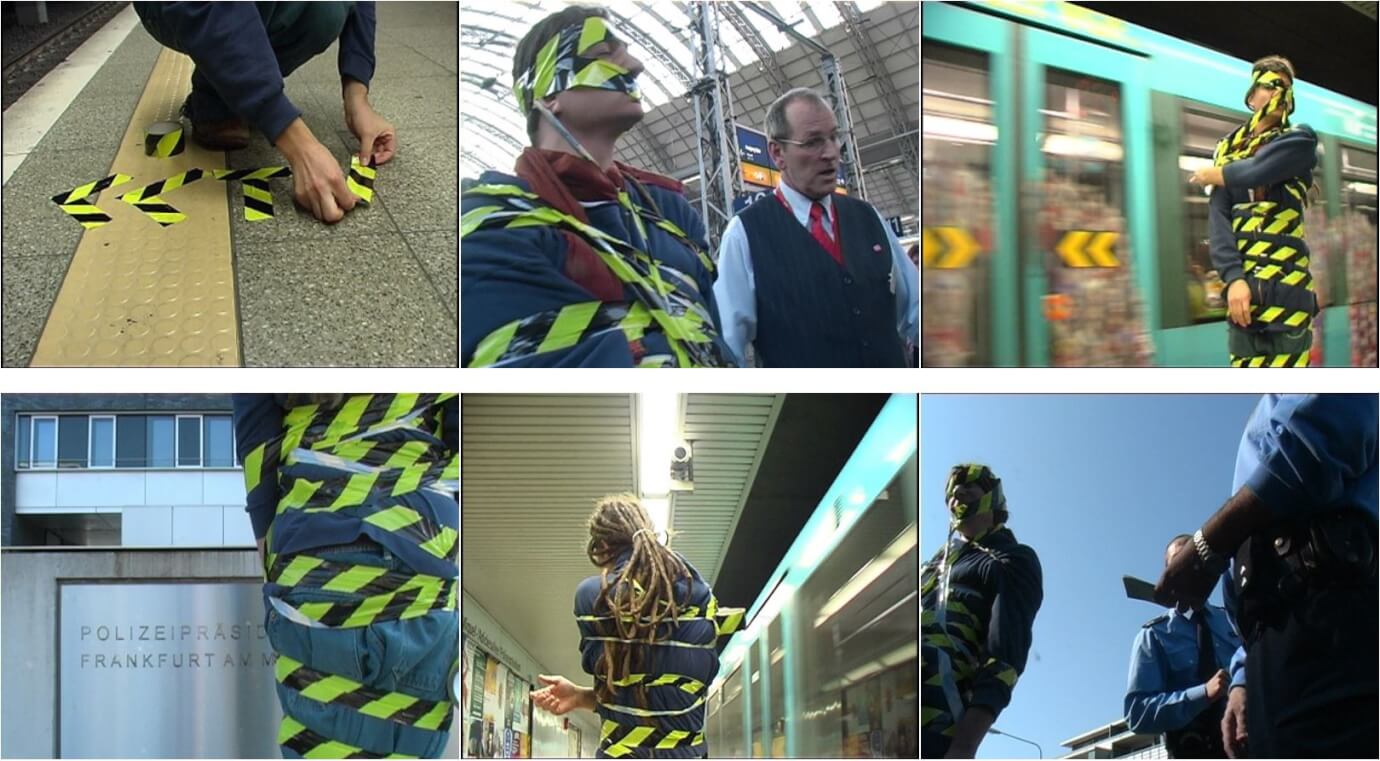
The security guards and police who faced me seemed helpless in their reactions. As an artist doing a performance that was neither a direct threat to public security, nor an open form of protest, I was still challenging the institutions to react to me. Yet I did not fit into the dangerous-versus-harmless dichotomy within which security forces operate. The officials eventually had to release my cameramen and me because we were merely ‘looking back.’ But my ensuing discussions with these police officers, press representatives, and railway security officials revealed interesting insights into the workings of the surveillance systems and their representatives’ positions on visual surveillance in general. “We are only observing ourselves here,” a policeman told me, “if you want to protest against video surveillance, go to the central station.” I understood this as an official incitement to carry my artistic form of protest to different places in the city. In my video installation, this conversation allows for a meta-perspective about the sanctioning of artistic and political actions. As in Manu Luksch’s video, here the conflicting tasks and roles of the police become apparent, as well as the loopholes that this strategy offers for subversive interventions in public space. Rules and regulations for behavior in public spaces are under constant negotiation. What is judged as accepted behavior can quickly change, and it does so in an ever-greater pace as the duties and functions of security forces become extended due to rising terrorist threats. A seemingly harmless, playful intervention in public space can open new perspectives and possibilities for political action — and it can show the tight limits and severe constraints under which we all live in our urbanized environments.
4_Legal Translations
Another aspect of Law’s Pluralities was addressed in a group of artworks that dealt with legal language and legal writing, with problems of translation, and with the adaptation of legal texts in visual arts. These works propose new visual readings of seminal constitutional texts and fictional readings of symbolic architectural embodiments of judicial power. They highlight the ambiguities and potential dangers of legal writing and its assumed untranslatability.
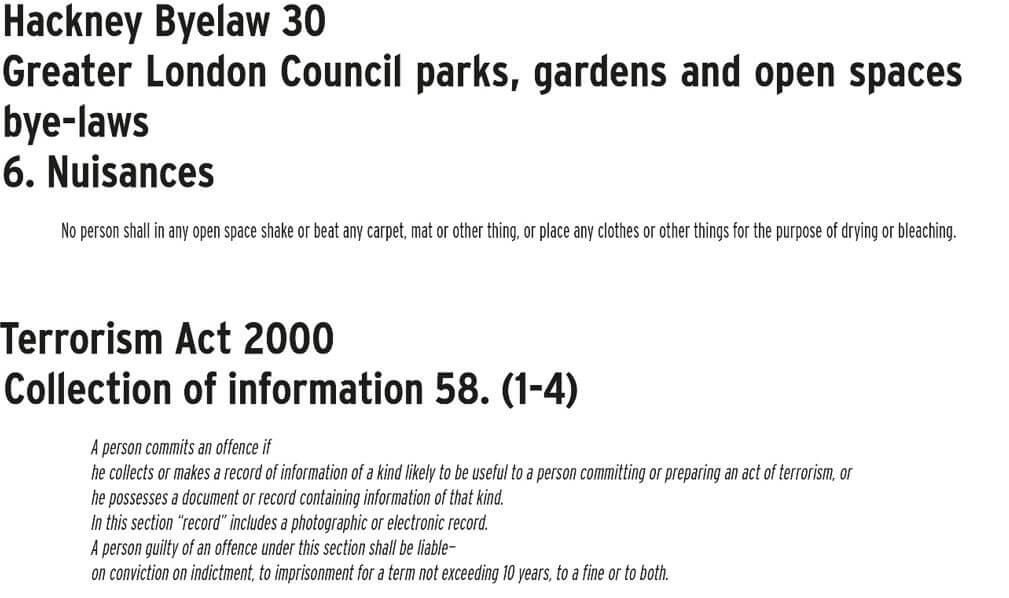
Read selected legal excerpts from Manu Luksch’s Limitations Permitted.
In Limitations Permitted, Manu Luksch directly addresses legal writing. She examines outdated and obsolete laws that still remain in effect, as well as new anti-terror legislation: laws that could potentially lead to the criminalization of casual activities. The installation consists of a stereoscopic viewer and a poster soberly noting these laws and regulations. In the Terrorism Act especially, wide ranging restrictions of civil liberties are legalized — a fact that most people in the UK are not aware of. Most tourists are not aware of it either: think twice, next time, before taking out your camera in London.

Luksch’s work, however, does not stop at the mere statement of legal absurdities; it takes the examination of legal language and its unintelligibility further. In the short clips shown in the stereoscopic viewer, the artist asks people who can communicate in sign language to translate the selected legal texts into this non-verbal language. We see people standing in potentially significant public places, filmed slightly from above, struggling for ‘signs’ to explain the legal circumstances. Limitations Permitted comments on the complexity of legal language, as well as the untranslatability and absurdity of certain legal circumstances. Yet for the majority of viewers — those unable to understand sign language — the translation functions as a vehicle of productive estrangement. Through this non-verbal translation of a complex legal language that itself often remains opaque to non-professional readers, the artist allows new perspectives on the metaphorical speechlessness in relation to certain legal issues. For the layperson, it often does not suffice to read legal texts twice to get the meaning and implications right. More often than not, we do in fact need a translator in the guise of a lawyer.
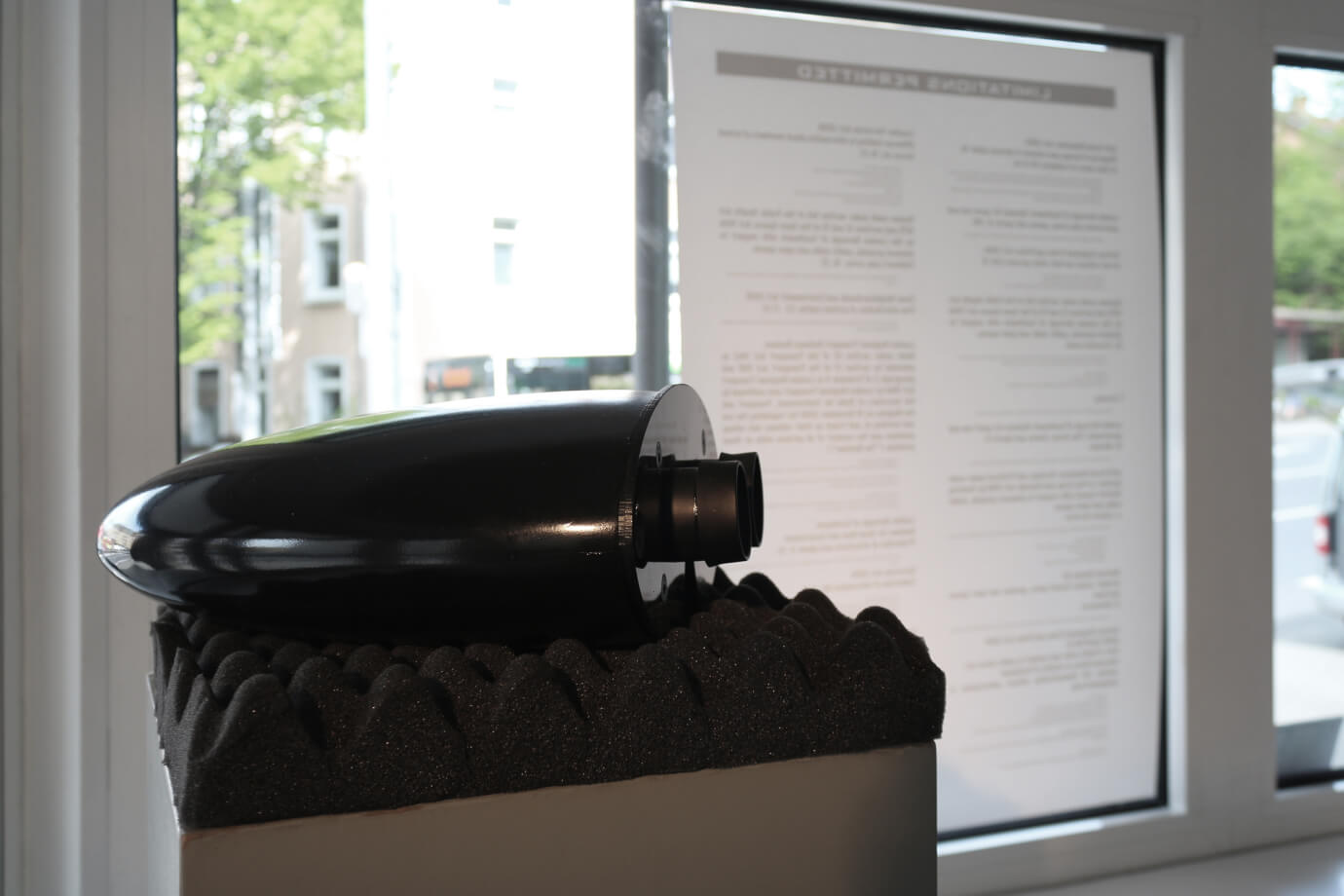
A very different form of legal writing and legal translation is proposed by the Frankfurt-based artist Il-Jin (Atem) Choi, whose creative composition of words originates in his practice as graffiti artist. In his drawing of the Preamble of the Universal Declaration of Human Rights, the artist builds a veritable ‘tower of words’ — an edifice of humaneness. But some of the graffiti-style letters seem to be inflated and to lose foothold in the tower structure; signs become distorted and reading becomes difficult: can this staggering monument eventually prevail?
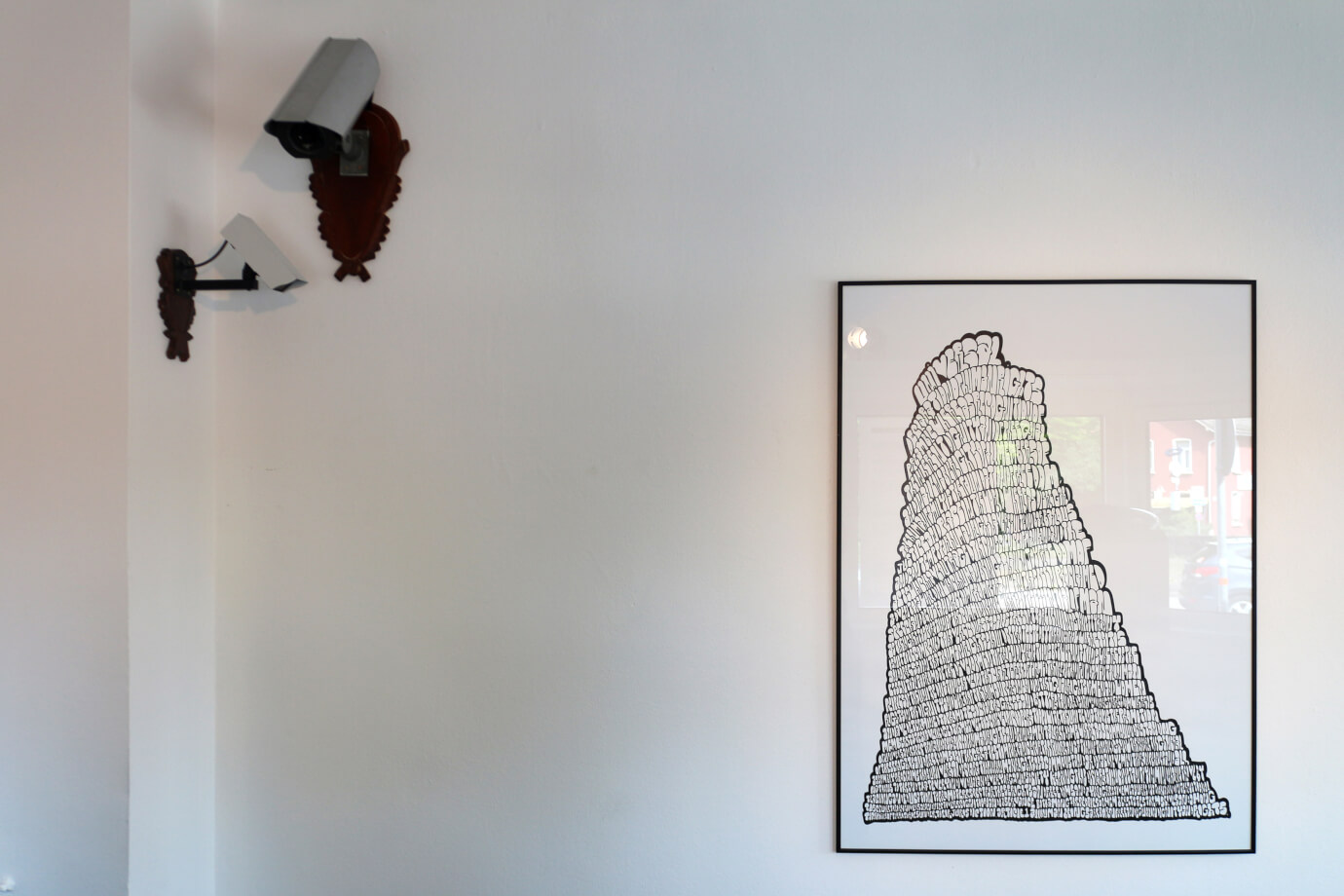
The installation The Architect by Mi You, an artist from Bejing, China, who is now based in Cologne, Germany, consists of two photographs and a printed text. The fictional reportage traces the architect behind the photographed building — a courthouse in Shanghai that resembles the Palais de Justice in Brussels. The installation questions the appropriation of Western classical architecture in China, and the artist’s fictional conversation with the architect reveals views on architecture that ironically twist discourses on architectural theory and the aesthetics of the copy. The Architect alludes to the transience of architecture, its afterlife, and the alteration of meaning of symbols of state power in different cultural contexts. Here the fictional narrative and the imagined encounter with the architect represent a productive artistic strategy to re-contextualize the neutral black-and white photos of the Chinese courthouse. The architect is described as a thoughtful protagonist who takes liberties in reassembling established architectural conventions, emphasizing the value of the copy and its cultural construction.
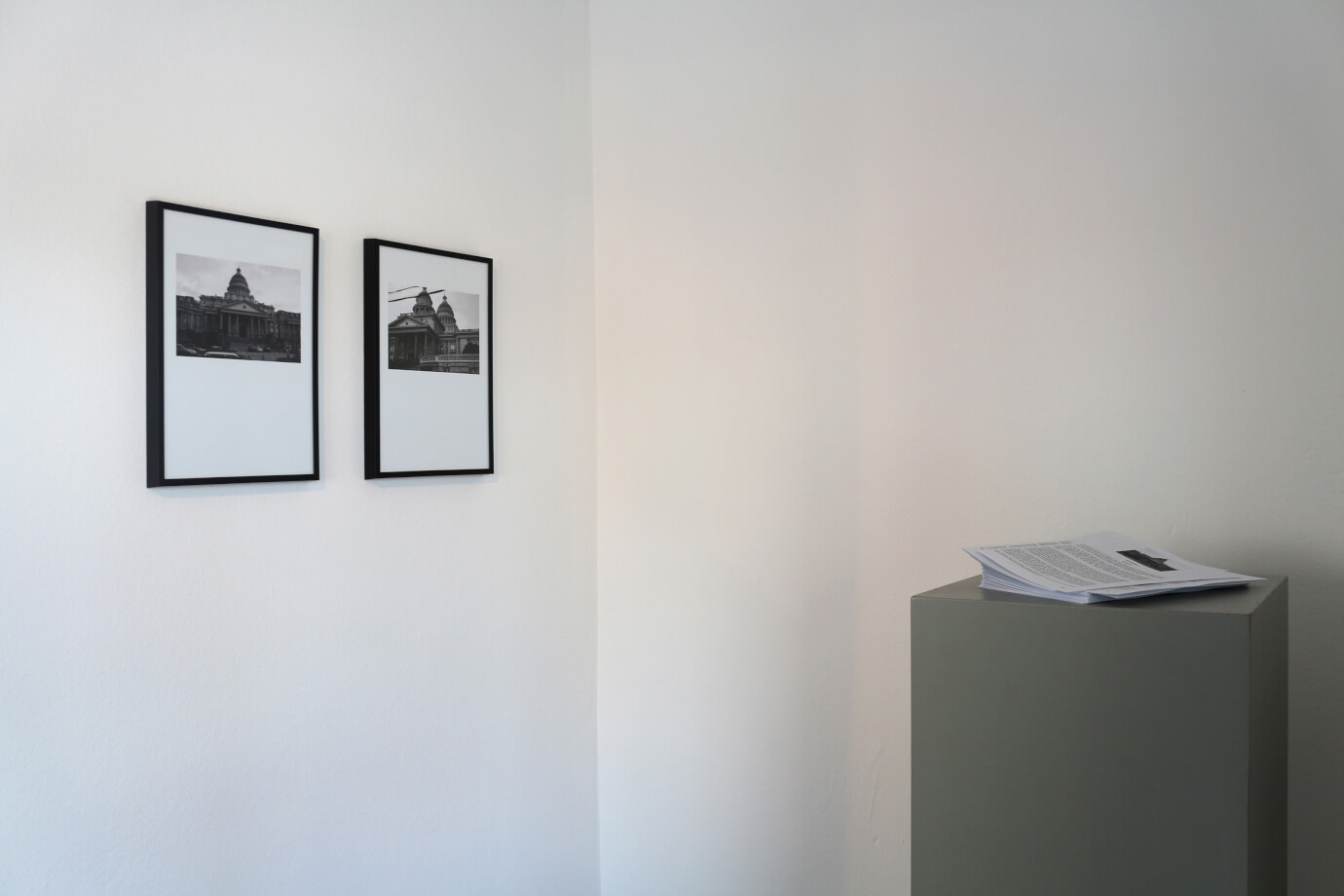
Read the fictional reportage The Architect.
The photos of the courthouse appear to be snapshots that could indeed have been taken in Europe or Northern America. Only upon second glance can the emblem of the Chinese government be discerned in the neoclassical pediment above the entrances. The front entrance to the building is huge, the back astonishingly scaled down, a fact that is also pointed out in the accompanying text. Here, more political readings come to mind: is the building some kind of an architectural Freudian slip, an image for big and small versions of the law, and a justice system that measures with different scales? When one considers the current condition of the justice system in China, where all too often justice seems a matter of influence and affluence, and where dissidents and disgraced party members are convicted in show trials, this architectural fairytale reveals a more somber side.
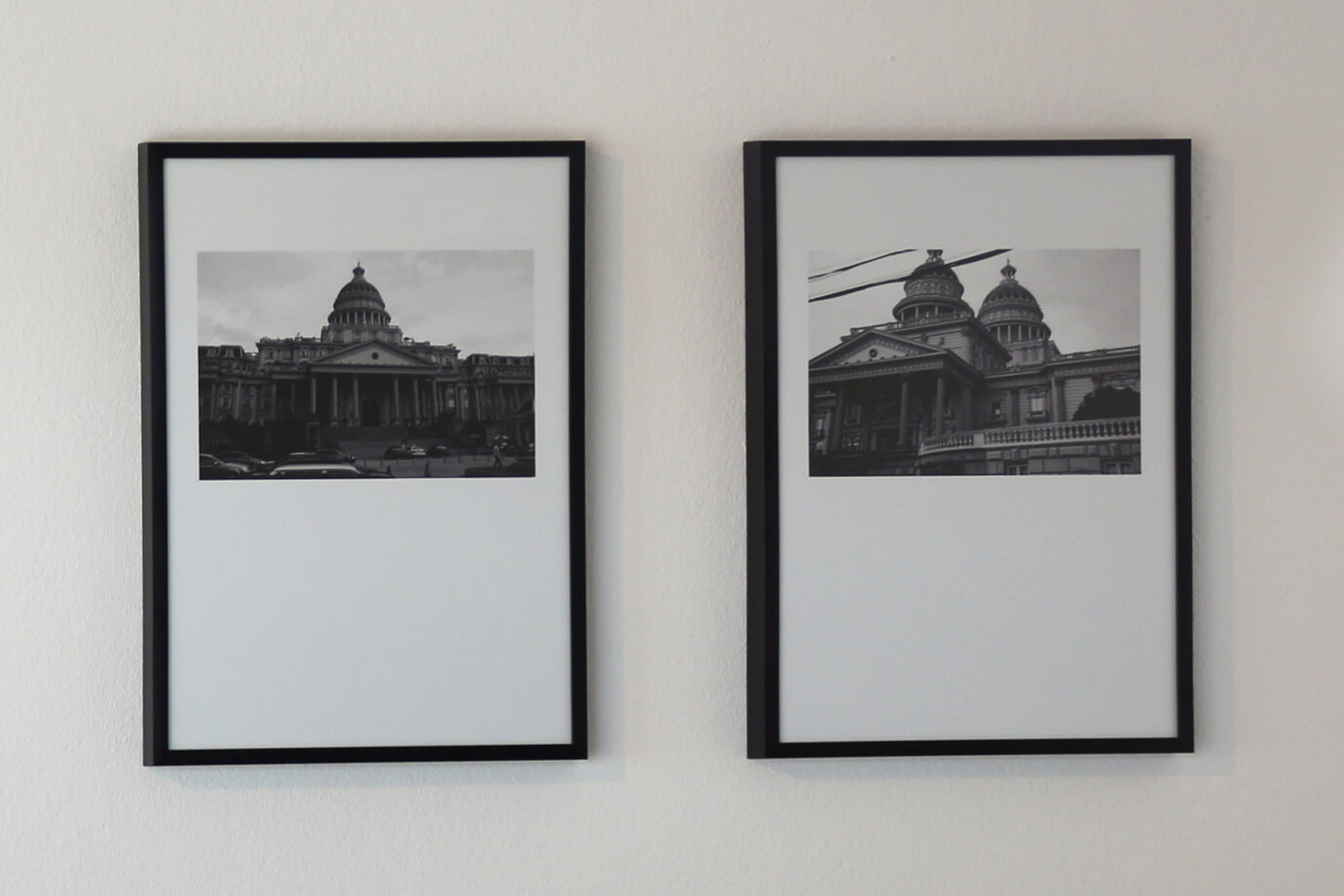
5_Visualizing Law’s Pluralities
Ultimately, the exhibition became rather monochrome, black and white, and formally straight: perhaps this was a concession to prevalent understandings of law and legal issues as small print on piles of paper, and as estranged from real life. Yet the worlds that unfold behind the individual works are far from colorless. The exhibition opened perspectives on the pluralities of law that lay the foundation for how we live together in increasingly regulated and contested urban spaces. And the pluralism of the artworks goes even further: they propose counter-hegemonic positions to prevalent norms and power structures and constitute alternative forms of knowledge that mirror the plurality and multiplicity of perspectives on law and legal culture.
Visual arts can become a strong means of providing images of intricate, non-visual issues. Videos and performances allow us to grasp complex phenomena such as the systematics of surveillance and the legal conditions that permit their existence, as well as the effects of the invisible accumulation of data on prevailing understandings of privacy that are brought about through the invisible accumulation of data. Interventions in public spaces develop a subversive, empowering potential. They playfully explore rules and regulations; they turn the passers-by and the exhibition viewers into accomplices; they offer new, sometimes humorous perspectives; and they provoke active, self-conscious behavior in relation to norms and authorities. The installations and drawings make perceptible the over-regulation of urban spaces and question the power relations and immutability of legal language. The photographs and fictional narratives ironically disenchant and recharge symbols of legal power, and they question myths of legal impartiality.
As part of the conference, this exhibition exemplified the pluralities of laws as well as the cultural construction and ongoing negotiation of legal issues. The artworks formulated strong positions in relation to legal discourses and critically commented on legal developments and their practical applications. These artistic perspectives and their contextualization in the exhibition, in the setting of the conference, offered a space for transdisciplinary encounters between theory and practice, between arts and science, and between cultural and legal studies.
_How to Cite
Raul Gschrey. “Visualizing Law’s Pluralities: Artistic Practice and Legal Culture.” On_Culture: The Open Journal for the Study of Culture 3 (2017). <http://geb.uni-giessen.de/geb/volltexte/2017/12995/>.
_Endnotes
- [1] Greta Olson, “Introduction: Mapping the Pluralist Character of Cultural Approaches to Law,” in German Law Journal 18.2 (2017), 243–254, here: 234.
- [2] See, e.g: Susan S. Silbe, “Legal Culture and Cultures of Legality,” in Handbook of Cultural Sociology, eds. John R. Hall, Laura Grindstaff, and Ming-Ceng Lo (London/New York: Routledge, 2010), 470–479; Lesley J. Moran, “Legal Studies after the Cultural Turn: A Case Study of Judicial Research,” in Social Research after the Cultural Turn, eds. Sacha Roseneil and Steven Frosch (London: Palgrave Macmillan, 2012), 124–143; Anne Wagner and Rickard K. Sherwin, eds., Law, Culture and Visual Studies (Berlin: Springer, 2014); Greta Olson and Franz Reimer, eds., “Special Issue: Law’s Pluralities: Arguments for Cultural Approaches to Law,” in German Law Journal 18.2 (2017).
- [3] Cf. Raul Gschrey, “Opening the Closed Circuit: Artistic Practices in Spaces under Surveillance,” in Experiencing Space – Spacing Experience: Concepts, Practices, and Materialities, eds. Nora Berning, Philipp Schulte, and Christine Schwanecke (Trier: WVT, 2014), 259–273.
- [4] Luksch refers to the material she retrieves through the legal process as ‘legal ready-mades.’ See: Manu Luksch and Mukul Patel, eds., Ambient Information Systems (London: AIS Ltd., 2009).
- [5] See, among others: Michael Klier, The Giant, 1983, video (Berlin: filmgalerie 451, 2012).
- [6] Manu Luksch and Mukul Patel, “Chasing the Data Shadow,” in Ambient Information Systems, eds. Manu Luksch and Mukul Patel (London: AIS Ltd., 2009), 276–295, here: 290.
- [7] Cf. David Lyon, The Electronic Eye: The Rise of Surveillance Society (Minneapolis: Minnesota UP, 1994).
- [8] Cf. Kevin D. Haggerty and Richard V. Ericson, “The surveillant assemblage,” in British Journal of Sociology 51.4 (2000), 605–622.
- [9] Cf. Gschrey, “Opening the Closed Circuit,” (cf. note 3), 259–273.
- [10] For an extended discussion of my artistic works in public space, see: Raul Gschrey, “Über-Wachen: Perspektiven auf Beobachtung und Überwachung in urbanen Räumen,” in Synthesen, eds. werkbund.jung and Frank Münschke (Frankfurt (Main)/Mainz/Essen: Klartext Medien Verlag, 2011), 134–147; Raul Gschrey, “Borderlines: Surveillance, Identification and Artistic Explorations along European Borders,” in Surveillance & Society 9.1 (2011) Surveillance and New Media Art, 185–202.
- [11] See, e.g.: Francisco Klauser, Die Videoüberwachung öffentlicher Räume – Zur Ambivalenz eines Instruments sozialer Kontrolle (Frankfurt (Main)/New York: Campus Forschung, 2006).
- [12] See the online journal “Surveillance & Society” <http://surveillance-and-society.org/> and the website of the “Surveillance Studies Network” <http://www.surveillance-studies.net/>, accessed June 21, 2017.



